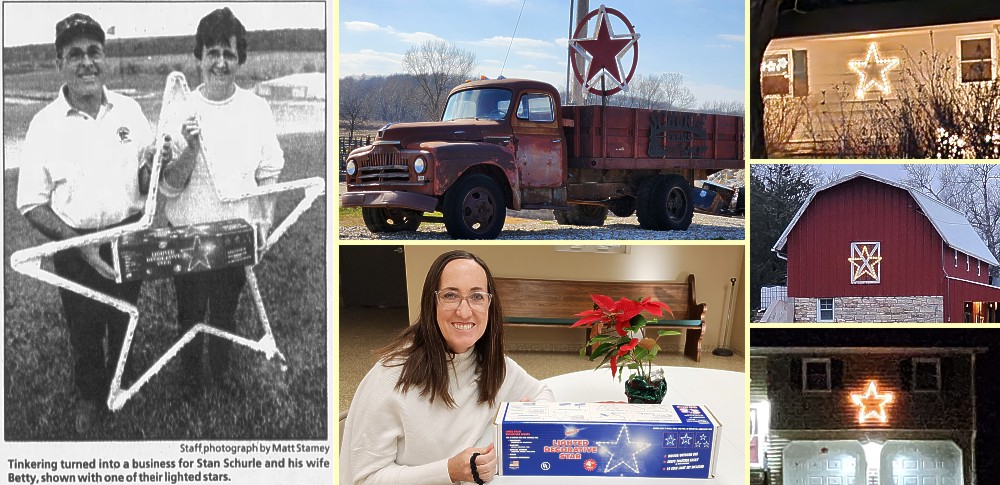Kansas Snapshots by Gloria Freeland - December 20, 2024
Starry starry nights
Coming from a farm family, I'm familiar with the need to be resourceful. Having equipment break down while dodging showers at harvest
time can turn an otherwise profitable year into one of red ink. The farmer who has to wait on someone to repair his farm implements is
at a disadvantage.
But those same skills that can keep a farmer in the field when he needs to be there can also be used in other ways. Such was the case
when a local live nativity - "Bethlehem Revisited" - was staged at the Judd and Nancy Swihart farm just up the road from where we live.
More than 100 people participate in costumes each year, portraying Mary, Joseph, prophets, angels, merchants, Roman soldiers, shepherds,
and the wise men. The production includes horses, a donkey, sheep, chickens, and calves. About 2,000 visit the nativity, sponsored by
Grace Baptist Church.
Being about Christmas, the Swiharts needed a star ... but not a puny one like those found in the Christmas aisles in local stores. After
all, the Bible says of Jesus' birth:
…and lo, the star, which they had seen in the east, went on before them, until it came and stood over where the Child was.
Matthew 2:9
Stars also figure prominently in another staple of the Christmas season - a tree with lights. According to one tale, Martin Luther, the
16th-century Protestant reformer, was walking home one winter evening and was amazed by the stars twinkling through the evergreens. To
recapture the scene for his family, he put up a tree and placed lighted candles among its branches.
Whether that is fact or fiction, no one can deny that stars have been one of the symbols of the season for a long time. There are star
tree toppers, ornaments, decorations on packages, and cookie cutters. Even some people who don't celebrate Christmas believe a bright star
in the night sky is a symbol of hope during the darkest part of the year.
Certainly, every nativity scene requires one, so Judd asked neighbor Jeff Schurle if he would make a large lighted star for the
"Bethlehem Revisited" production. According to Jeff's sister Karen, he worked on the star a while, but then decided it was a project
better suited for his dad Stan, who was good at "tinkering" with things around his farm.
But for some reason, Stan didn't look at the request as just a project to help out his neighbor. Certainly there must be others who would
like a large lighted star to place on the side of their home or perhaps on a barn. Maybe there was a business opportunity here.
The star Stan created for the living nativity used iron, but he realized that this heavy material made a star that would make
shipping expensive. So he worked on a plastic version to make it lightweight. It needed to be easy to assemble and ship. But before
looking into manufacturing them, he and wife Betty checked with the U.S. patent office in Wichita to make sure there wasn't something
similar that already had a patent. There wasn't.
While visiting Betty's relatives in Calgary, Canada, they found a business to make a prototype. It took about 12 weeks to make the mold.
But they decided shipping costs from Canada would be prohibitive, so they found a company in El Dorado, Kansas to manufacture the
four-foot stars.
The plastic pieces can be assembled without tools in just a few minutes and are lightweight. Each plastic piece has slots for mounting a
string of lights. The Schurle family's friend Kevin Robel designed the red-white-and-blue shipping box that has the following information:
S&S Stars
Lighted Decorative Star
More than Christmas lights. Use a lighted star (or several) for: holidays (Independence Day, Memorial Day);
parties (birthday,
anniversary, prom); special events (graduations, banquets, sports events); sales; grand openings
Mounts easily to house, fence, pole/post, or display in a landscaped yard
Indoor/outdoor use
Snaps together easily (no tools necessary)
50-bulb light set included
Those skills honed on the farm had been useful in creating a star not just for a neighbor's event, but for hundreds of other situations
as well. They sold by word-of-mouth as well as at various businesses - an office supply store, hardware stores, and a lumber company in Wichita.
They were sent to people in other states - Ohio, Missouri, Texas, Montana, Virginia, California, Idaho and South Dakota. One even made
its way to Canada.
That star project was 25 years ago. At the time, the Schurles and their patented stars were featured in an article in the local Manhattan
Mercury newspaper. And while the family no longer actively markets the stars, there are some left in storage and Karen said
a few people still reach out every year, especially at Christmas.
Husband Art and I have long admired these large lighted stars which adorn area homes and barns. Some people have them lit up all year
long, but many are seen primarily during the holiday season. Stan has a leftover from the design process mounted on an old pickup truck.
It makes me smile whenever I pass by their home.
This year's winter solstice - the shortest day in the Northern Hemisphere and the official first day of winter - will be tomorrow. But
for many, Stan's stars will make that long night just a little brighter and seem a little bit warmer.
(Anyone interested in purchasing a star, contact Karen at: [email protected]. $20 each, plus shipping)
